Assessing the Impact of Climate Change on E-Flows in Mekong River Basin
VerifiedAdded on 2023/01/11
|15
|3992
|31
AI Summary
This study assesses the effects of climate change on e-flows at basin scale in the Mekong River Basin. It analyzes the changes in mean annual runoff and the temporal dynamics of river discharge, and evaluates the impact on freshwater-dependent biota and habitat availability.
Contribute Materials
Your contribution can guide someone’s learning journey. Share your
documents today.

Environmental Flaws
Secure Best Marks with AI Grader
Need help grading? Try our AI Grader for instant feedback on your assignments.
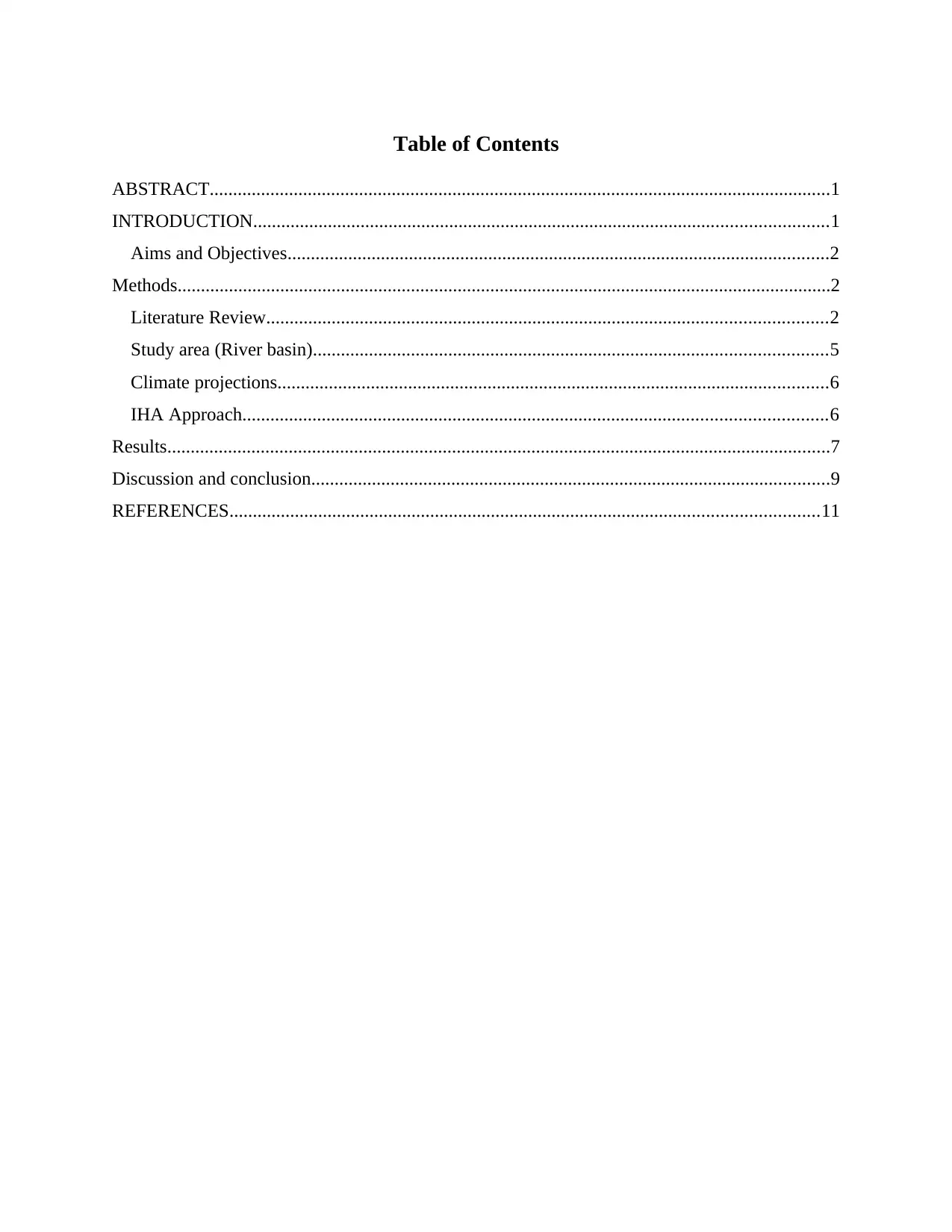
Table of Contents
ABSTRACT.....................................................................................................................................1
INTRODUCTION...........................................................................................................................1
Aims and Objectives....................................................................................................................2
Methods............................................................................................................................................2
Literature Review........................................................................................................................2
Study area (River basin)..............................................................................................................5
Climate projections......................................................................................................................6
IHA Approach.............................................................................................................................6
Results..............................................................................................................................................7
Discussion and conclusion...............................................................................................................9
REFERENCES..............................................................................................................................11
ABSTRACT.....................................................................................................................................1
INTRODUCTION...........................................................................................................................1
Aims and Objectives....................................................................................................................2
Methods............................................................................................................................................2
Literature Review........................................................................................................................2
Study area (River basin)..............................................................................................................5
Climate projections......................................................................................................................6
IHA Approach.............................................................................................................................6
Results..............................................................................................................................................7
Discussion and conclusion...............................................................................................................9
REFERENCES..............................................................................................................................11

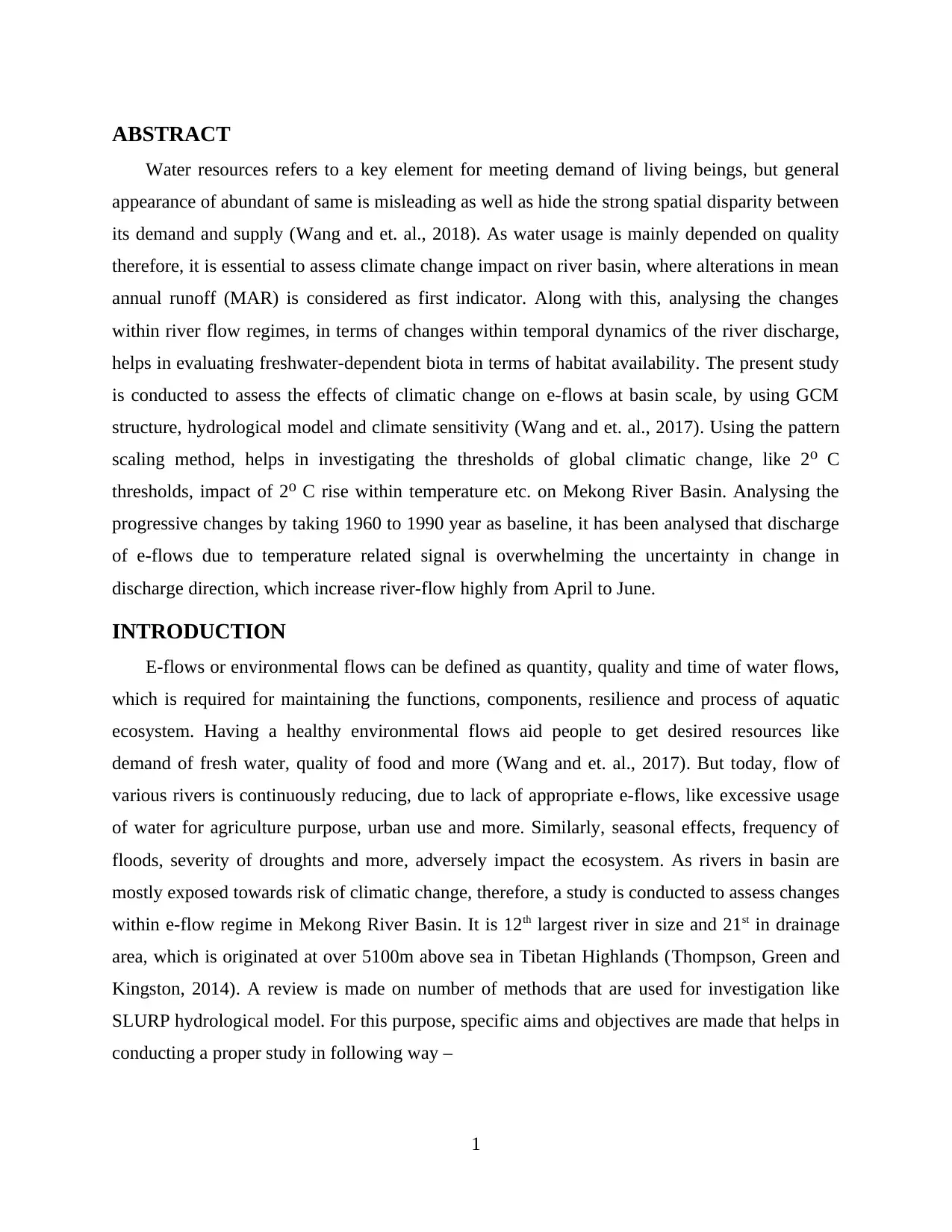
ABSTRACT
Water resources refers to a key element for meeting demand of living beings, but general
appearance of abundant of same is misleading as well as hide the strong spatial disparity between
its demand and supply (Wang and et. al., 2018). As water usage is mainly depended on quality
therefore, it is essential to assess climate change impact on river basin, where alterations in mean
annual runoff (MAR) is considered as first indicator. Along with this, analysing the changes
within river flow regimes, in terms of changes within temporal dynamics of the river discharge,
helps in evaluating freshwater-dependent biota in terms of habitat availability. The present study
is conducted to assess the effects of climatic change on e-flows at basin scale, by using GCM
structure, hydrological model and climate sensitivity (Wang and et. al., 2017). Using the pattern
scaling method, helps in investigating the thresholds of global climatic change, like 2 C⁰
thresholds, impact of 2 C rise within temperature etc. on Mekong River Basin. Analysing the⁰
progressive changes by taking 1960 to 1990 year as baseline, it has been analysed that discharge
of e-flows due to temperature related signal is overwhelming the uncertainty in change in
discharge direction, which increase river-flow highly from April to June.
INTRODUCTION
E-flows or environmental flows can be defined as quantity, quality and time of water flows,
which is required for maintaining the functions, components, resilience and process of aquatic
ecosystem. Having a healthy environmental flows aid people to get desired resources like
demand of fresh water, quality of food and more (Wang and et. al., 2017). But today, flow of
various rivers is continuously reducing, due to lack of appropriate e-flows, like excessive usage
of water for agriculture purpose, urban use and more. Similarly, seasonal effects, frequency of
floods, severity of droughts and more, adversely impact the ecosystem. As rivers in basin are
mostly exposed towards risk of climatic change, therefore, a study is conducted to assess changes
within e-flow regime in Mekong River Basin. It is 12th largest river in size and 21st in drainage
area, which is originated at over 5100m above sea in Tibetan Highlands (Thompson, Green and
Kingston, 2014). A review is made on number of methods that are used for investigation like
SLURP hydrological model. For this purpose, specific aims and objectives are made that helps in
conducting a proper study in following way –
1
Water resources refers to a key element for meeting demand of living beings, but general
appearance of abundant of same is misleading as well as hide the strong spatial disparity between
its demand and supply (Wang and et. al., 2018). As water usage is mainly depended on quality
therefore, it is essential to assess climate change impact on river basin, where alterations in mean
annual runoff (MAR) is considered as first indicator. Along with this, analysing the changes
within river flow regimes, in terms of changes within temporal dynamics of the river discharge,
helps in evaluating freshwater-dependent biota in terms of habitat availability. The present study
is conducted to assess the effects of climatic change on e-flows at basin scale, by using GCM
structure, hydrological model and climate sensitivity (Wang and et. al., 2017). Using the pattern
scaling method, helps in investigating the thresholds of global climatic change, like 2 C⁰
thresholds, impact of 2 C rise within temperature etc. on Mekong River Basin. Analysing the⁰
progressive changes by taking 1960 to 1990 year as baseline, it has been analysed that discharge
of e-flows due to temperature related signal is overwhelming the uncertainty in change in
discharge direction, which increase river-flow highly from April to June.
INTRODUCTION
E-flows or environmental flows can be defined as quantity, quality and time of water flows,
which is required for maintaining the functions, components, resilience and process of aquatic
ecosystem. Having a healthy environmental flows aid people to get desired resources like
demand of fresh water, quality of food and more (Wang and et. al., 2017). But today, flow of
various rivers is continuously reducing, due to lack of appropriate e-flows, like excessive usage
of water for agriculture purpose, urban use and more. Similarly, seasonal effects, frequency of
floods, severity of droughts and more, adversely impact the ecosystem. As rivers in basin are
mostly exposed towards risk of climatic change, therefore, a study is conducted to assess changes
within e-flow regime in Mekong River Basin. It is 12th largest river in size and 21st in drainage
area, which is originated at over 5100m above sea in Tibetan Highlands (Thompson, Green and
Kingston, 2014). A review is made on number of methods that are used for investigation like
SLURP hydrological model. For this purpose, specific aims and objectives are made that helps in
conducting a proper study in following way –
1
Secure Best Marks with AI Grader
Need help grading? Try our AI Grader for instant feedback on your assignments.
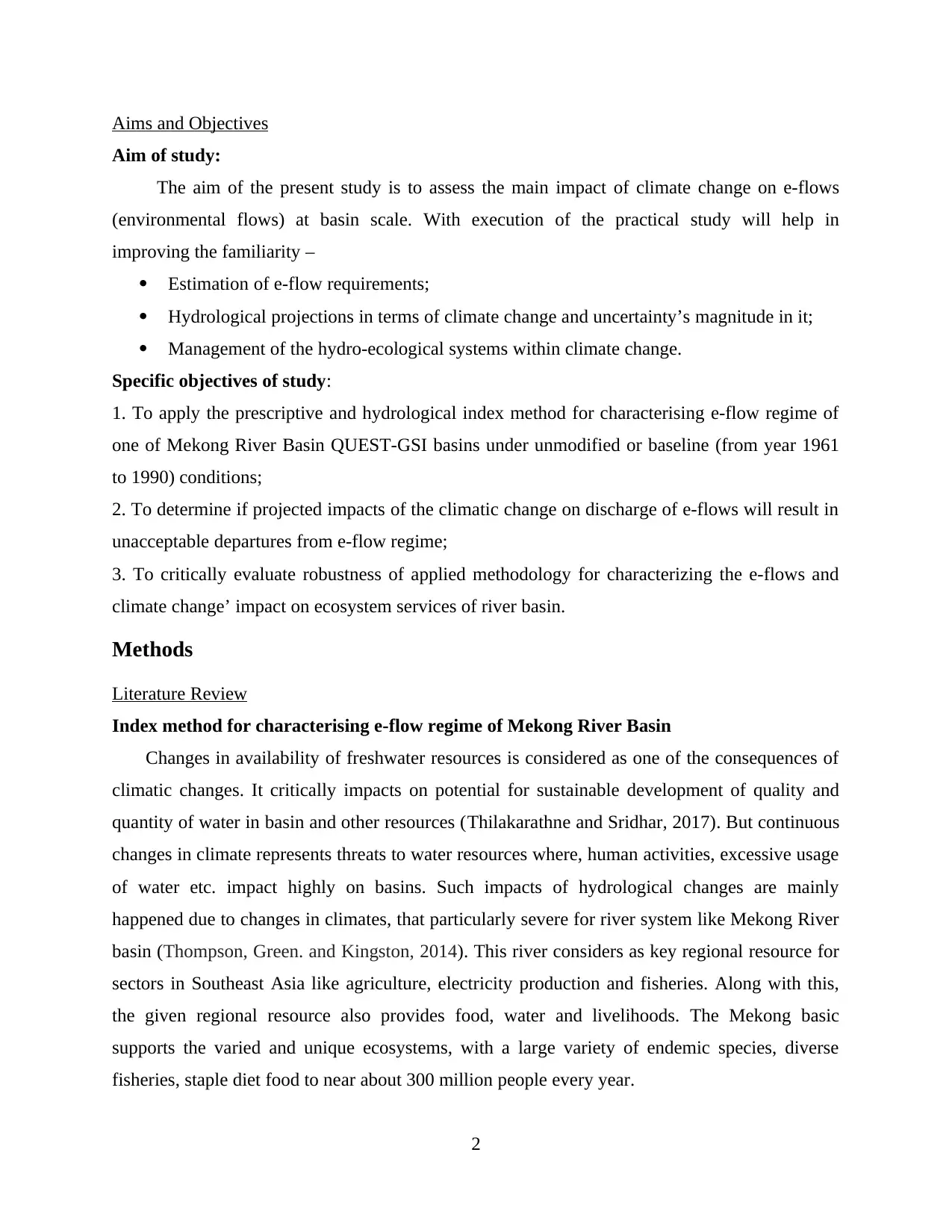
Aims and Objectives
Aim of study:
The aim of the present study is to assess the main impact of climate change on e-flows
(environmental flows) at basin scale. With execution of the practical study will help in
improving the familiarity –
Estimation of e-flow requirements;
Hydrological projections in terms of climate change and uncertainty’s magnitude in it;
Management of the hydro-ecological systems within climate change.
Specific objectives of study:
1. To apply the prescriptive and hydrological index method for characterising e-flow regime of
one of Mekong River Basin QUEST-GSI basins under unmodified or baseline (from year 1961
to 1990) conditions;
2. To determine if projected impacts of the climatic change on discharge of e-flows will result in
unacceptable departures from e-flow regime;
3. To critically evaluate robustness of applied methodology for characterizing the e-flows and
climate change’ impact on ecosystem services of river basin.
Methods
Literature Review
Index method for characterising e-flow regime of Mekong River Basin
Changes in availability of freshwater resources is considered as one of the consequences of
climatic changes. It critically impacts on potential for sustainable development of quality and
quantity of water in basin and other resources (Thilakarathne and Sridhar, 2017). But continuous
changes in climate represents threats to water resources where, human activities, excessive usage
of water etc. impact highly on basins. Such impacts of hydrological changes are mainly
happened due to changes in climates, that particularly severe for river system like Mekong River
basin (Thompson, Green. and Kingston, 2014). This river considers as key regional resource for
sectors in Southeast Asia like agriculture, electricity production and fisheries. Along with this,
the given regional resource also provides food, water and livelihoods. The Mekong basic
supports the varied and unique ecosystems, with a large variety of endemic species, diverse
fisheries, staple diet food to near about 300 million people every year.
2
Aim of study:
The aim of the present study is to assess the main impact of climate change on e-flows
(environmental flows) at basin scale. With execution of the practical study will help in
improving the familiarity –
Estimation of e-flow requirements;
Hydrological projections in terms of climate change and uncertainty’s magnitude in it;
Management of the hydro-ecological systems within climate change.
Specific objectives of study:
1. To apply the prescriptive and hydrological index method for characterising e-flow regime of
one of Mekong River Basin QUEST-GSI basins under unmodified or baseline (from year 1961
to 1990) conditions;
2. To determine if projected impacts of the climatic change on discharge of e-flows will result in
unacceptable departures from e-flow regime;
3. To critically evaluate robustness of applied methodology for characterizing the e-flows and
climate change’ impact on ecosystem services of river basin.
Methods
Literature Review
Index method for characterising e-flow regime of Mekong River Basin
Changes in availability of freshwater resources is considered as one of the consequences of
climatic changes. It critically impacts on potential for sustainable development of quality and
quantity of water in basin and other resources (Thilakarathne and Sridhar, 2017). But continuous
changes in climate represents threats to water resources where, human activities, excessive usage
of water etc. impact highly on basins. Such impacts of hydrological changes are mainly
happened due to changes in climates, that particularly severe for river system like Mekong River
basin (Thompson, Green. and Kingston, 2014). This river considers as key regional resource for
sectors in Southeast Asia like agriculture, electricity production and fisheries. Along with this,
the given regional resource also provides food, water and livelihoods. The Mekong basic
supports the varied and unique ecosystems, with a large variety of endemic species, diverse
fisheries, staple diet food to near about 300 million people every year.
2
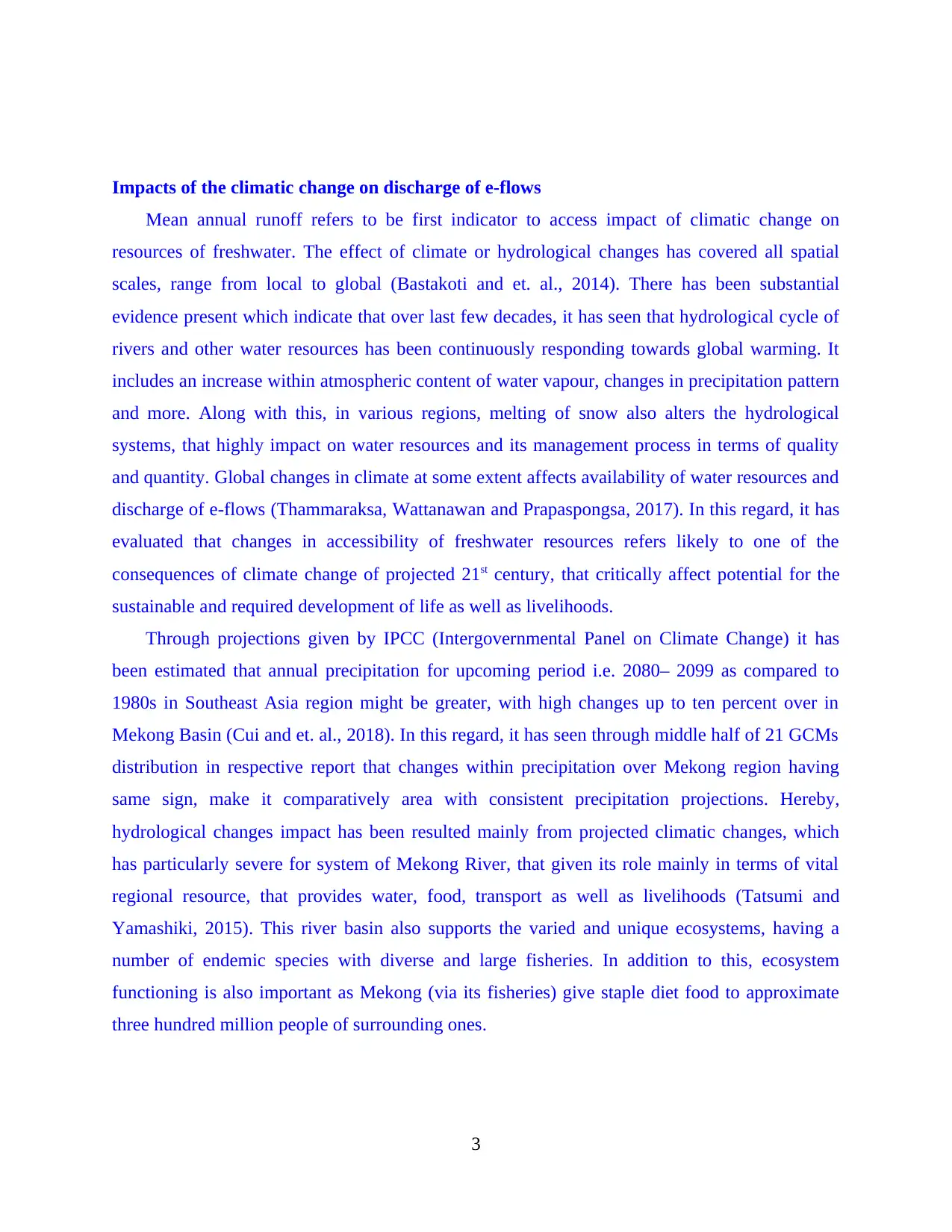
Impacts of the climatic change on discharge of e-flows
Mean annual runoff refers to be first indicator to access impact of climatic change on
resources of freshwater. The effect of climate or hydrological changes has covered all spatial
scales, range from local to global (Bastakoti and et. al., 2014). There has been substantial
evidence present which indicate that over last few decades, it has seen that hydrological cycle of
rivers and other water resources has been continuously responding towards global warming. It
includes an increase within atmospheric content of water vapour, changes in precipitation pattern
and more. Along with this, in various regions, melting of snow also alters the hydrological
systems, that highly impact on water resources and its management process in terms of quality
and quantity. Global changes in climate at some extent affects availability of water resources and
discharge of e-flows (Thammaraksa, Wattanawan and Prapaspongsa, 2017). In this regard, it has
evaluated that changes in accessibility of freshwater resources refers likely to one of the
consequences of climate change of projected 21st century, that critically affect potential for the
sustainable and required development of life as well as livelihoods.
Through projections given by IPCC (Intergovernmental Panel on Climate Change) it has
been estimated that annual precipitation for upcoming period i.e. 2080– 2099 as compared to
1980s in Southeast Asia region might be greater, with high changes up to ten percent over in
Mekong Basin (Cui and et. al., 2018). In this regard, it has seen through middle half of 21 GCMs
distribution in respective report that changes within precipitation over Mekong region having
same sign, make it comparatively area with consistent precipitation projections. Hereby,
hydrological changes impact has been resulted mainly from projected climatic changes, which
has particularly severe for system of Mekong River, that given its role mainly in terms of vital
regional resource, that provides water, food, transport as well as livelihoods (Tatsumi and
Yamashiki, 2015). This river basin also supports the varied and unique ecosystems, having a
number of endemic species with diverse and large fisheries. In addition to this, ecosystem
functioning is also important as Mekong (via its fisheries) give staple diet food to approximate
three hundred million people of surrounding ones.
3
Mean annual runoff refers to be first indicator to access impact of climatic change on
resources of freshwater. The effect of climate or hydrological changes has covered all spatial
scales, range from local to global (Bastakoti and et. al., 2014). There has been substantial
evidence present which indicate that over last few decades, it has seen that hydrological cycle of
rivers and other water resources has been continuously responding towards global warming. It
includes an increase within atmospheric content of water vapour, changes in precipitation pattern
and more. Along with this, in various regions, melting of snow also alters the hydrological
systems, that highly impact on water resources and its management process in terms of quality
and quantity. Global changes in climate at some extent affects availability of water resources and
discharge of e-flows (Thammaraksa, Wattanawan and Prapaspongsa, 2017). In this regard, it has
evaluated that changes in accessibility of freshwater resources refers likely to one of the
consequences of climate change of projected 21st century, that critically affect potential for the
sustainable and required development of life as well as livelihoods.
Through projections given by IPCC (Intergovernmental Panel on Climate Change) it has
been estimated that annual precipitation for upcoming period i.e. 2080– 2099 as compared to
1980s in Southeast Asia region might be greater, with high changes up to ten percent over in
Mekong Basin (Cui and et. al., 2018). In this regard, it has seen through middle half of 21 GCMs
distribution in respective report that changes within precipitation over Mekong region having
same sign, make it comparatively area with consistent precipitation projections. Hereby,
hydrological changes impact has been resulted mainly from projected climatic changes, which
has particularly severe for system of Mekong River, that given its role mainly in terms of vital
regional resource, that provides water, food, transport as well as livelihoods (Tatsumi and
Yamashiki, 2015). This river basin also supports the varied and unique ecosystems, having a
number of endemic species with diverse and large fisheries. In addition to this, ecosystem
functioning is also important as Mekong (via its fisheries) give staple diet food to approximate
three hundred million people of surrounding ones.
3
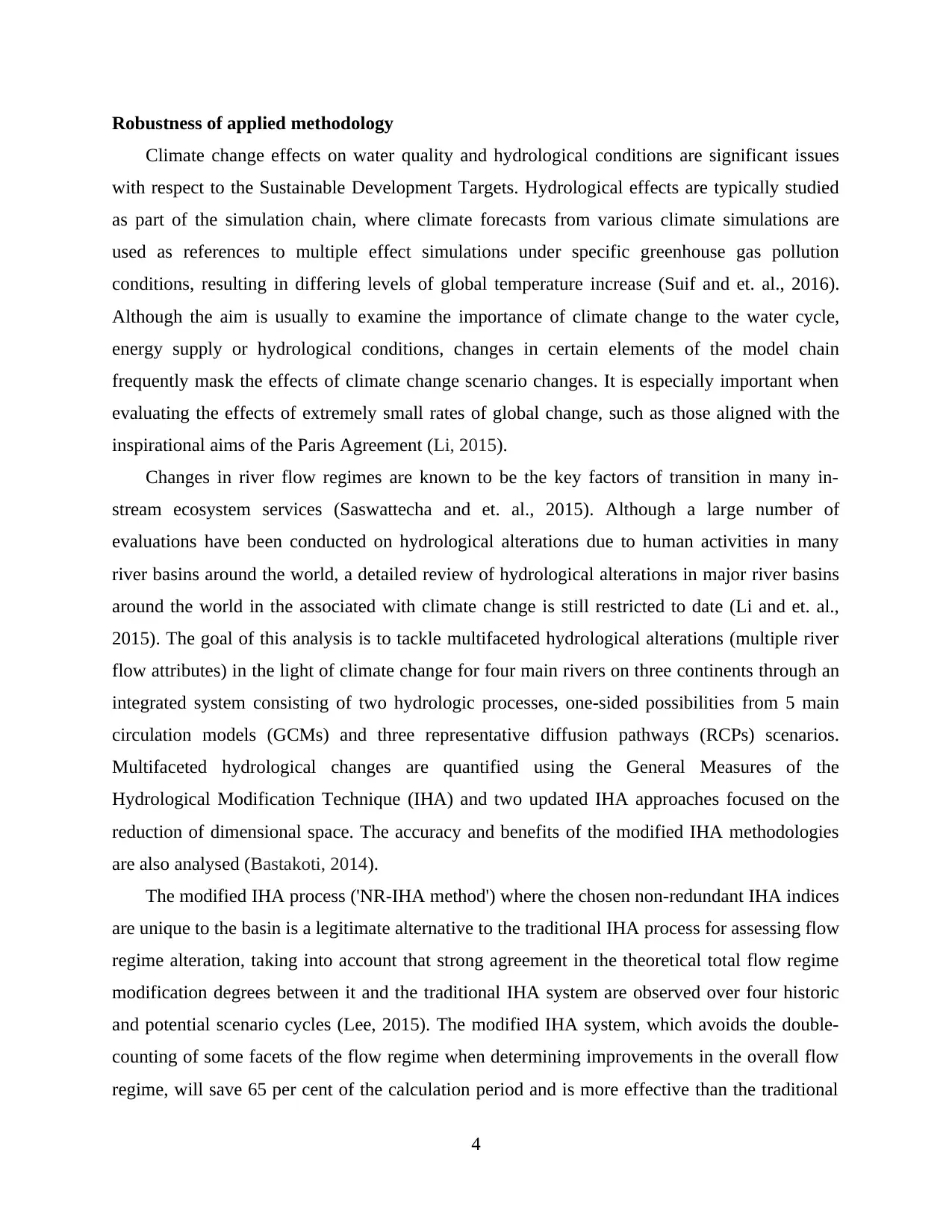
Robustness of applied methodology
Climate change effects on water quality and hydrological conditions are significant issues
with respect to the Sustainable Development Targets. Hydrological effects are typically studied
as part of the simulation chain, where climate forecasts from various climate simulations are
used as references to multiple effect simulations under specific greenhouse gas pollution
conditions, resulting in differing levels of global temperature increase (Suif and et. al., 2016).
Although the aim is usually to examine the importance of climate change to the water cycle,
energy supply or hydrological conditions, changes in certain elements of the model chain
frequently mask the effects of climate change scenario changes. It is especially important when
evaluating the effects of extremely small rates of global change, such as those aligned with the
inspirational aims of the Paris Agreement (Li, 2015).
Changes in river flow regimes are known to be the key factors of transition in many in-
stream ecosystem services (Saswattecha and et. al., 2015). Although a large number of
evaluations have been conducted on hydrological alterations due to human activities in many
river basins around the world, a detailed review of hydrological alterations in major river basins
around the world in the associated with climate change is still restricted to date (Li and et. al.,
2015). The goal of this analysis is to tackle multifaceted hydrological alterations (multiple river
flow attributes) in the light of climate change for four main rivers on three continents through an
integrated system consisting of two hydrologic processes, one-sided possibilities from 5 main
circulation models (GCMs) and three representative diffusion pathways (RCPs) scenarios.
Multifaceted hydrological changes are quantified using the General Measures of the
Hydrological Modification Technique (IHA) and two updated IHA approaches focused on the
reduction of dimensional space. The accuracy and benefits of the modified IHA methodologies
are also analysed (Bastakoti, 2014).
The modified IHA process ('NR-IHA method') where the chosen non-redundant IHA indices
are unique to the basin is a legitimate alternative to the traditional IHA process for assessing flow
regime alteration, taking into account that strong agreement in the theoretical total flow regime
modification degrees between it and the traditional IHA system are observed over four historic
and potential scenario cycles (Lee, 2015). The modified IHA system, which avoids the double-
counting of some facets of the flow regime when determining improvements in the overall flow
regime, will save 65 per cent of the calculation period and is more effective than the traditional
4
Climate change effects on water quality and hydrological conditions are significant issues
with respect to the Sustainable Development Targets. Hydrological effects are typically studied
as part of the simulation chain, where climate forecasts from various climate simulations are
used as references to multiple effect simulations under specific greenhouse gas pollution
conditions, resulting in differing levels of global temperature increase (Suif and et. al., 2016).
Although the aim is usually to examine the importance of climate change to the water cycle,
energy supply or hydrological conditions, changes in certain elements of the model chain
frequently mask the effects of climate change scenario changes. It is especially important when
evaluating the effects of extremely small rates of global change, such as those aligned with the
inspirational aims of the Paris Agreement (Li, 2015).
Changes in river flow regimes are known to be the key factors of transition in many in-
stream ecosystem services (Saswattecha and et. al., 2015). Although a large number of
evaluations have been conducted on hydrological alterations due to human activities in many
river basins around the world, a detailed review of hydrological alterations in major river basins
around the world in the associated with climate change is still restricted to date (Li and et. al.,
2015). The goal of this analysis is to tackle multifaceted hydrological alterations (multiple river
flow attributes) in the light of climate change for four main rivers on three continents through an
integrated system consisting of two hydrologic processes, one-sided possibilities from 5 main
circulation models (GCMs) and three representative diffusion pathways (RCPs) scenarios.
Multifaceted hydrological changes are quantified using the General Measures of the
Hydrological Modification Technique (IHA) and two updated IHA approaches focused on the
reduction of dimensional space. The accuracy and benefits of the modified IHA methodologies
are also analysed (Bastakoti, 2014).
The modified IHA process ('NR-IHA method') where the chosen non-redundant IHA indices
are unique to the basin is a legitimate alternative to the traditional IHA process for assessing flow
regime alteration, taking into account that strong agreement in the theoretical total flow regime
modification degrees between it and the traditional IHA system are observed over four historic
and potential scenario cycles (Lee, 2015). The modified IHA system, which avoids the double-
counting of some facets of the flow regime when determining improvements in the overall flow
regime, will save 65 per cent of the calculation period and is more effective than the traditional
4
Paraphrase This Document
Need a fresh take? Get an instant paraphrase of this document with our AI Paraphraser
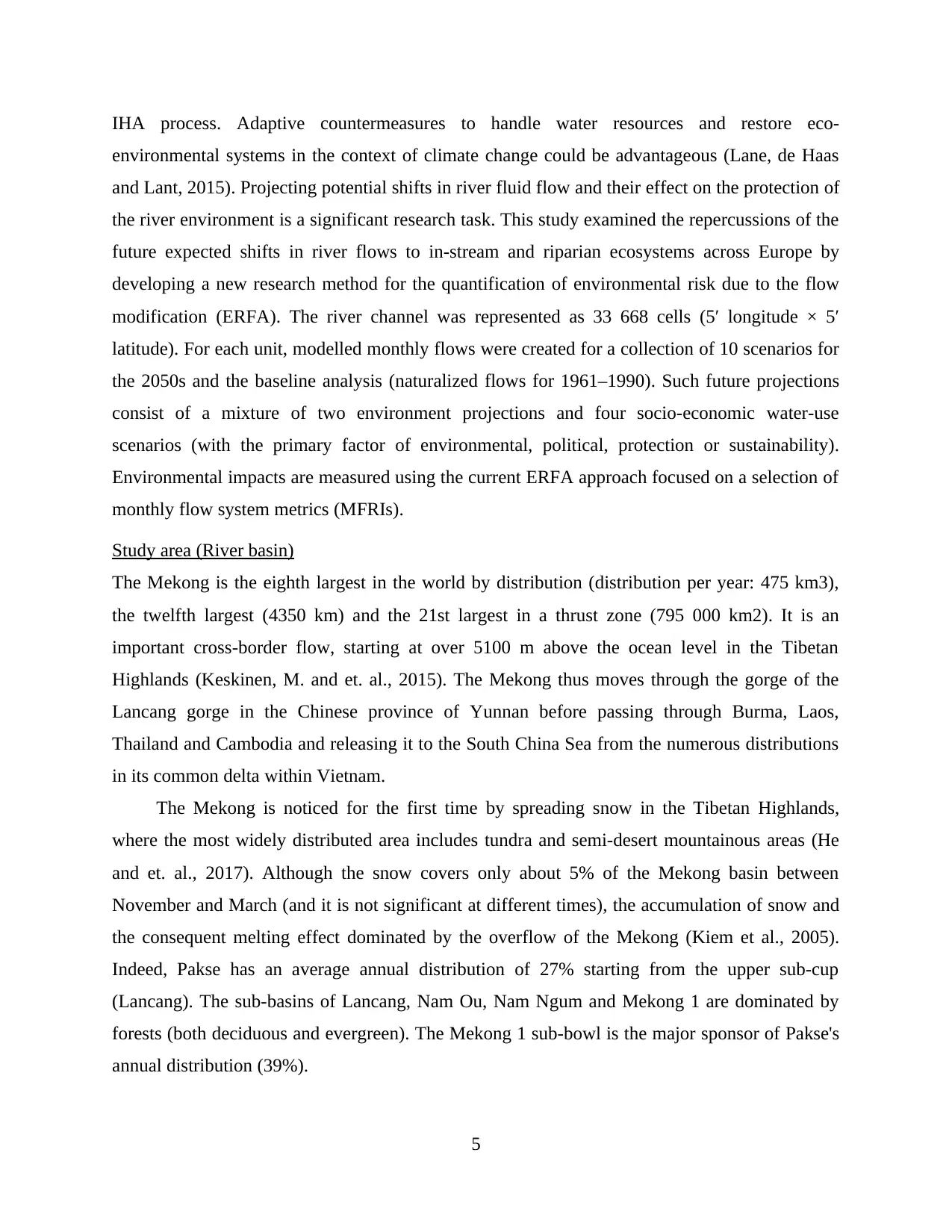
IHA process. Adaptive countermeasures to handle water resources and restore eco-
environmental systems in the context of climate change could be advantageous (Lane, de Haas
and Lant, 2015). Projecting potential shifts in river fluid flow and their effect on the protection of
the river environment is a significant research task. This study examined the repercussions of the
future expected shifts in river flows to in-stream and riparian ecosystems across Europe by
developing a new research method for the quantification of environmental risk due to the flow
modification (ERFA). The river channel was represented as 33 668 cells (5′ longitude × 5′
latitude). For each unit, modelled monthly flows were created for a collection of 10 scenarios for
the 2050s and the baseline analysis (naturalized flows for 1961–1990). Such future projections
consist of a mixture of two environment projections and four socio-economic water-use
scenarios (with the primary factor of environmental, political, protection or sustainability).
Environmental impacts are measured using the current ERFA approach focused on a selection of
monthly flow system metrics (MFRIs).
Study area (River basin)
The Mekong is the eighth largest in the world by distribution (distribution per year: 475 km3),
the twelfth largest (4350 km) and the 21st largest in a thrust zone (795 000 km2). It is an
important cross-border flow, starting at over 5100 m above the ocean level in the Tibetan
Highlands (Keskinen, M. and et. al., 2015). The Mekong thus moves through the gorge of the
Lancang gorge in the Chinese province of Yunnan before passing through Burma, Laos,
Thailand and Cambodia and releasing it to the South China Sea from the numerous distributions
in its common delta within Vietnam.
The Mekong is noticed for the first time by spreading snow in the Tibetan Highlands,
where the most widely distributed area includes tundra and semi-desert mountainous areas (He
and et. al., 2017). Although the snow covers only about 5% of the Mekong basin between
November and March (and it is not significant at different times), the accumulation of snow and
the consequent melting effect dominated by the overflow of the Mekong (Kiem et al., 2005).
Indeed, Pakse has an average annual distribution of 27% starting from the upper sub-cup
(Lancang). The sub-basins of Lancang, Nam Ou, Nam Ngum and Mekong 1 are dominated by
forests (both deciduous and evergreen). The Mekong 1 sub-bowl is the major sponsor of Pakse's
annual distribution (39%).
5
environmental systems in the context of climate change could be advantageous (Lane, de Haas
and Lant, 2015). Projecting potential shifts in river fluid flow and their effect on the protection of
the river environment is a significant research task. This study examined the repercussions of the
future expected shifts in river flows to in-stream and riparian ecosystems across Europe by
developing a new research method for the quantification of environmental risk due to the flow
modification (ERFA). The river channel was represented as 33 668 cells (5′ longitude × 5′
latitude). For each unit, modelled monthly flows were created for a collection of 10 scenarios for
the 2050s and the baseline analysis (naturalized flows for 1961–1990). Such future projections
consist of a mixture of two environment projections and four socio-economic water-use
scenarios (with the primary factor of environmental, political, protection or sustainability).
Environmental impacts are measured using the current ERFA approach focused on a selection of
monthly flow system metrics (MFRIs).
Study area (River basin)
The Mekong is the eighth largest in the world by distribution (distribution per year: 475 km3),
the twelfth largest (4350 km) and the 21st largest in a thrust zone (795 000 km2). It is an
important cross-border flow, starting at over 5100 m above the ocean level in the Tibetan
Highlands (Keskinen, M. and et. al., 2015). The Mekong thus moves through the gorge of the
Lancang gorge in the Chinese province of Yunnan before passing through Burma, Laos,
Thailand and Cambodia and releasing it to the South China Sea from the numerous distributions
in its common delta within Vietnam.
The Mekong is noticed for the first time by spreading snow in the Tibetan Highlands,
where the most widely distributed area includes tundra and semi-desert mountainous areas (He
and et. al., 2017). Although the snow covers only about 5% of the Mekong basin between
November and March (and it is not significant at different times), the accumulation of snow and
the consequent melting effect dominated by the overflow of the Mekong (Kiem et al., 2005).
Indeed, Pakse has an average annual distribution of 27% starting from the upper sub-cup
(Lancang). The sub-basins of Lancang, Nam Ou, Nam Ngum and Mekong 1 are dominated by
forests (both deciduous and evergreen). The Mekong 1 sub-bowl is the major sponsor of Pakse's
annual distribution (39%).
5
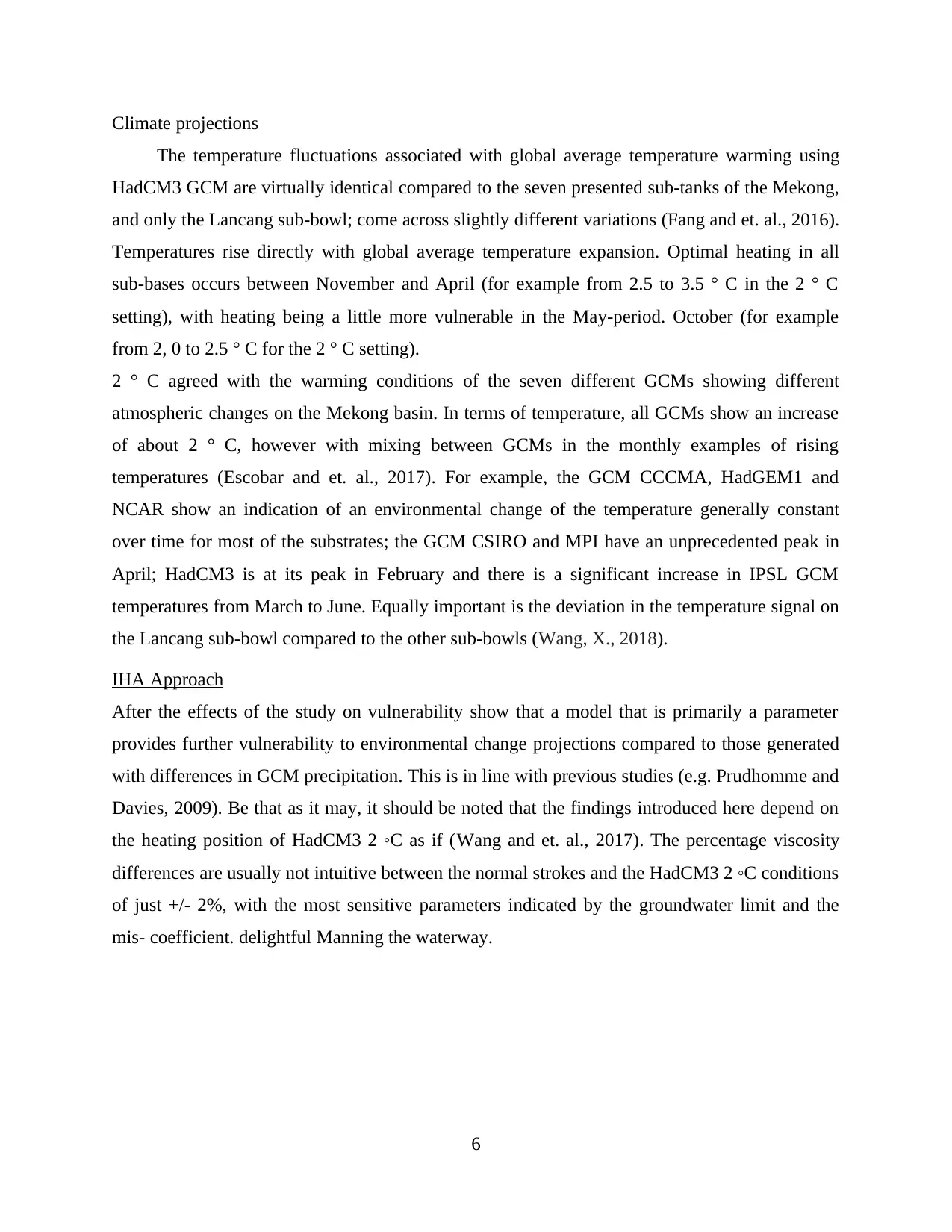
Climate projections
The temperature fluctuations associated with global average temperature warming using
HadCM3 GCM are virtually identical compared to the seven presented sub-tanks of the Mekong,
and only the Lancang sub-bowl; come across slightly different variations (Fang and et. al., 2016).
Temperatures rise directly with global average temperature expansion. Optimal heating in all
sub-bases occurs between November and April (for example from 2.5 to 3.5 ° C in the 2 ° C
setting), with heating being a little more vulnerable in the May-period. October (for example
from 2, 0 to 2.5 ° C for the 2 ° C setting).
2 ° C agreed with the warming conditions of the seven different GCMs showing different
atmospheric changes on the Mekong basin. In terms of temperature, all GCMs show an increase
of about 2 ° C, however with mixing between GCMs in the monthly examples of rising
temperatures (Escobar and et. al., 2017). For example, the GCM CCCMA, HadGEM1 and
NCAR show an indication of an environmental change of the temperature generally constant
over time for most of the substrates; the GCM CSIRO and MPI have an unprecedented peak in
April; HadCM3 is at its peak in February and there is a significant increase in IPSL GCM
temperatures from March to June. Equally important is the deviation in the temperature signal on
the Lancang sub-bowl compared to the other sub-bowls (Wang, X., 2018).
IHA Approach
After the effects of the study on vulnerability show that a model that is primarily a parameter
provides further vulnerability to environmental change projections compared to those generated
with differences in GCM precipitation. This is in line with previous studies (e.g. Prudhomme and
Davies, 2009). Be that as it may, it should be noted that the findings introduced here depend on
the heating position of HadCM3 2 ◦C as if (Wang and et. al., 2017). The percentage viscosity
differences are usually not intuitive between the normal strokes and the HadCM3 2 ◦C conditions
of just +/- 2%, with the most sensitive parameters indicated by the groundwater limit and the
mis- coefficient. delightful Manning the waterway.
6
The temperature fluctuations associated with global average temperature warming using
HadCM3 GCM are virtually identical compared to the seven presented sub-tanks of the Mekong,
and only the Lancang sub-bowl; come across slightly different variations (Fang and et. al., 2016).
Temperatures rise directly with global average temperature expansion. Optimal heating in all
sub-bases occurs between November and April (for example from 2.5 to 3.5 ° C in the 2 ° C
setting), with heating being a little more vulnerable in the May-period. October (for example
from 2, 0 to 2.5 ° C for the 2 ° C setting).
2 ° C agreed with the warming conditions of the seven different GCMs showing different
atmospheric changes on the Mekong basin. In terms of temperature, all GCMs show an increase
of about 2 ° C, however with mixing between GCMs in the monthly examples of rising
temperatures (Escobar and et. al., 2017). For example, the GCM CCCMA, HadGEM1 and
NCAR show an indication of an environmental change of the temperature generally constant
over time for most of the substrates; the GCM CSIRO and MPI have an unprecedented peak in
April; HadCM3 is at its peak in February and there is a significant increase in IPSL GCM
temperatures from March to June. Equally important is the deviation in the temperature signal on
the Lancang sub-bowl compared to the other sub-bowls (Wang, X., 2018).
IHA Approach
After the effects of the study on vulnerability show that a model that is primarily a parameter
provides further vulnerability to environmental change projections compared to those generated
with differences in GCM precipitation. This is in line with previous studies (e.g. Prudhomme and
Davies, 2009). Be that as it may, it should be noted that the findings introduced here depend on
the heating position of HadCM3 2 ◦C as if (Wang and et. al., 2017). The percentage viscosity
differences are usually not intuitive between the normal strokes and the HadCM3 2 ◦C conditions
of just +/- 2%, with the most sensitive parameters indicated by the groundwater limit and the
mis- coefficient. delightful Manning the waterway.
6
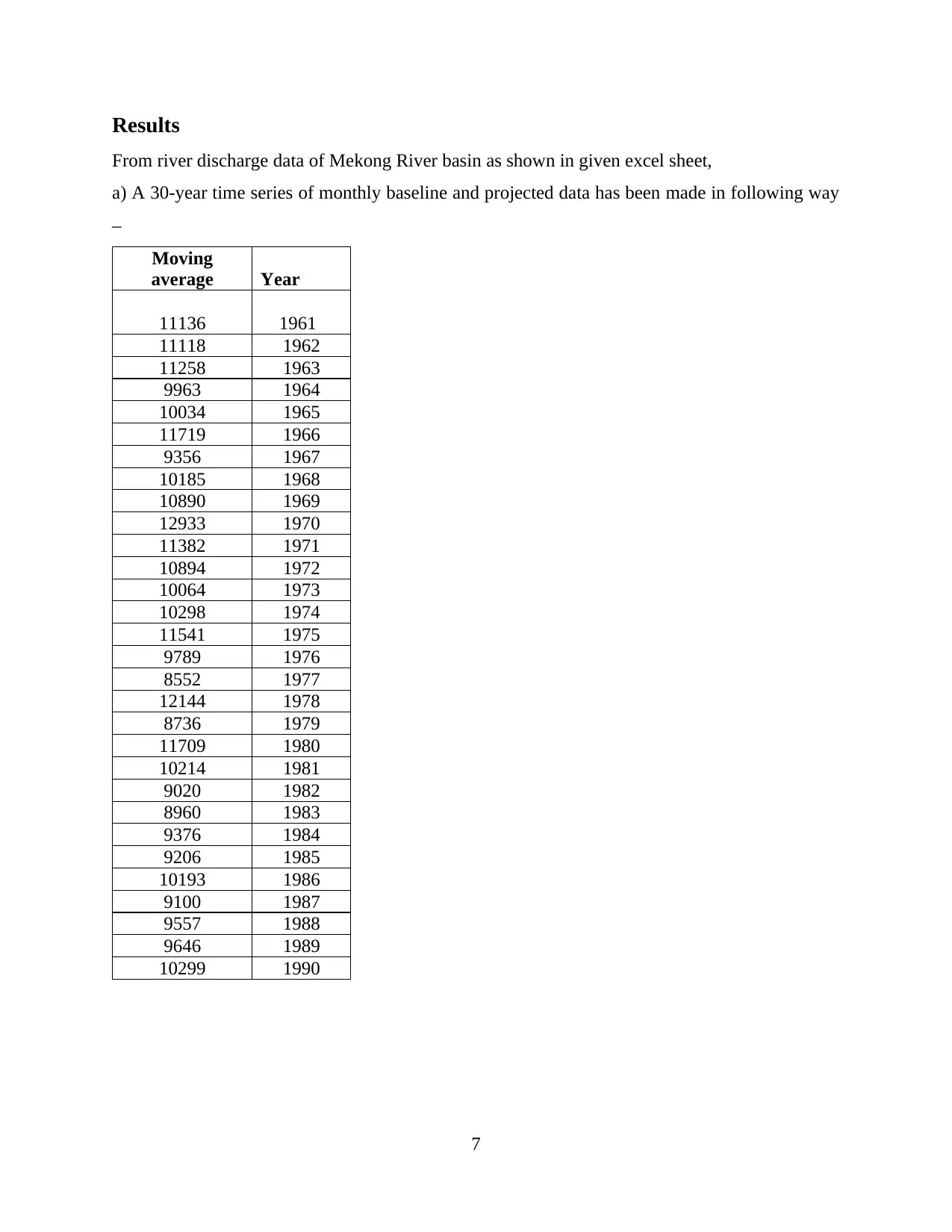
Results
From river discharge data of Mekong River basin as shown in given excel sheet,
a) A 30-year time series of monthly baseline and projected data has been made in following way
–
Moving
average Year
11136 1961
11118 1962
11258 1963
9963 1964
10034 1965
11719 1966
9356 1967
10185 1968
10890 1969
12933 1970
11382 1971
10894 1972
10064 1973
10298 1974
11541 1975
9789 1976
8552 1977
12144 1978
8736 1979
11709 1980
10214 1981
9020 1982
8960 1983
9376 1984
9206 1985
10193 1986
9100 1987
9557 1988
9646 1989
10299 1990
7
From river discharge data of Mekong River basin as shown in given excel sheet,
a) A 30-year time series of monthly baseline and projected data has been made in following way
–
Moving
average Year
11136 1961
11118 1962
11258 1963
9963 1964
10034 1965
11719 1966
9356 1967
10185 1968
10890 1969
12933 1970
11382 1971
10894 1972
10064 1973
10298 1974
11541 1975
9789 1976
8552 1977
12144 1978
8736 1979
11709 1980
10214 1981
9020 1982
8960 1983
9376 1984
9206 1985
10193 1986
9100 1987
9557 1988
9646 1989
10299 1990
7
Secure Best Marks with AI Grader
Need help grading? Try our AI Grader for instant feedback on your assignments.
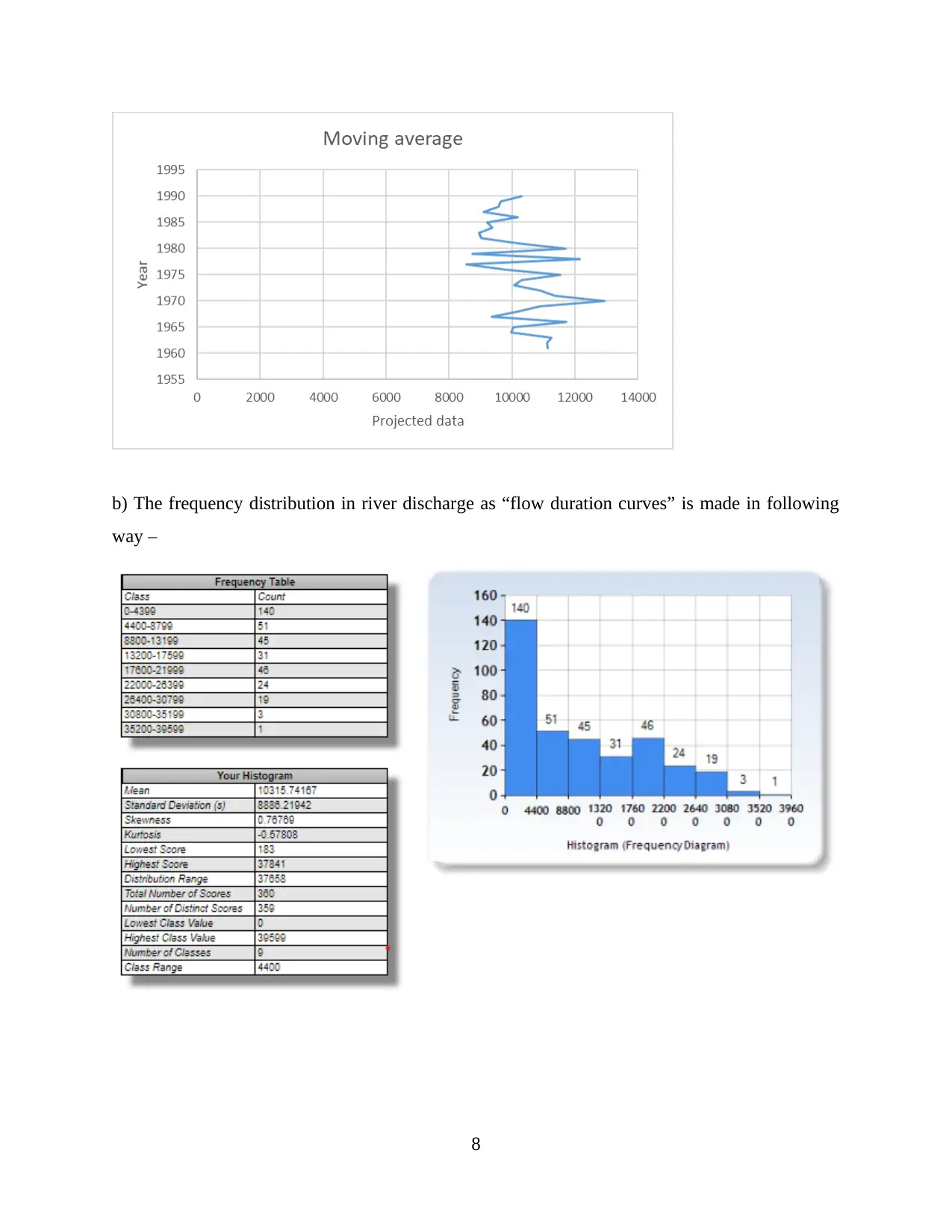
b) The frequency distribution in river discharge as “flow duration curves” is made in following
way –
8
way –
8
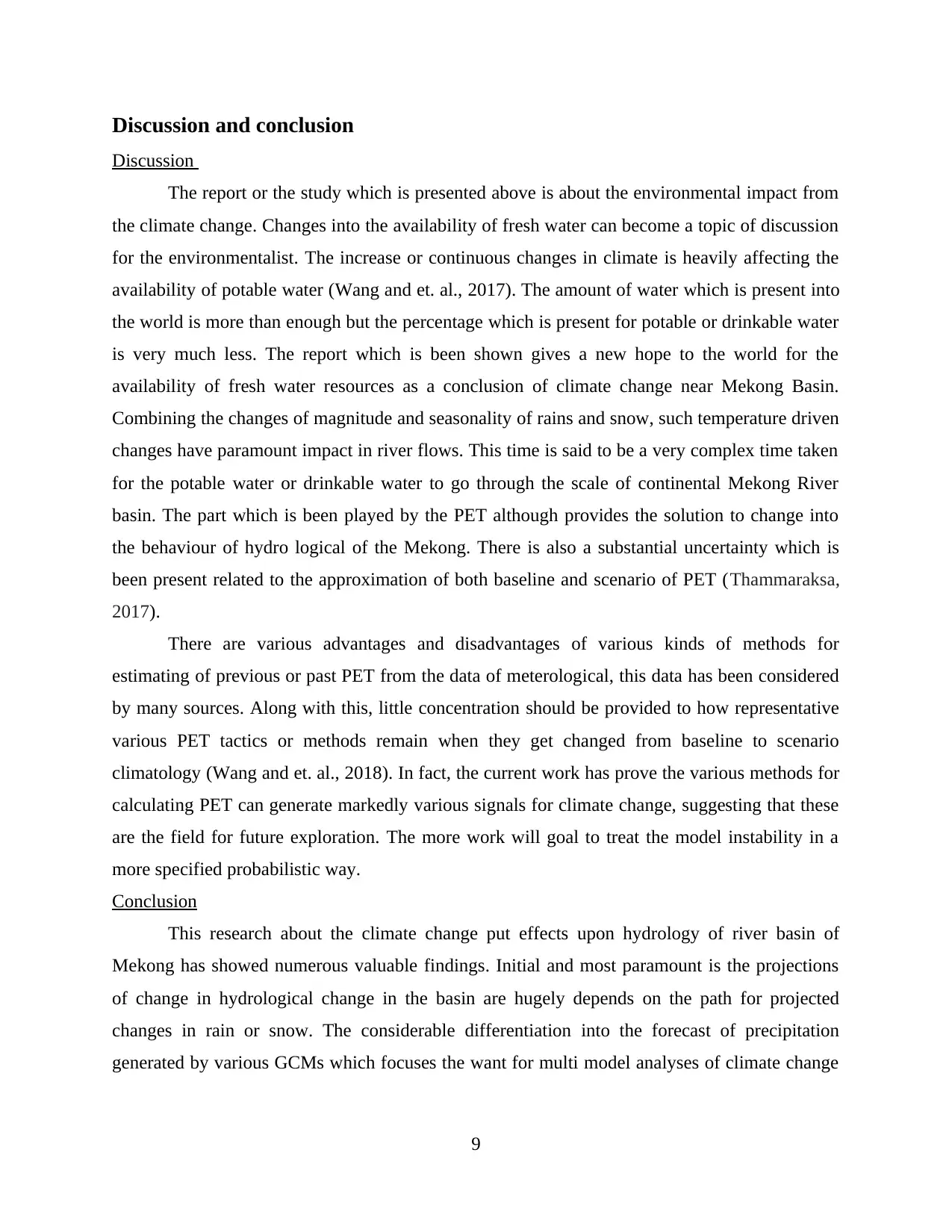
Discussion and conclusion
Discussion
The report or the study which is presented above is about the environmental impact from
the climate change. Changes into the availability of fresh water can become a topic of discussion
for the environmentalist. The increase or continuous changes in climate is heavily affecting the
availability of potable water (Wang and et. al., 2017). The amount of water which is present into
the world is more than enough but the percentage which is present for potable or drinkable water
is very much less. The report which is been shown gives a new hope to the world for the
availability of fresh water resources as a conclusion of climate change near Mekong Basin.
Combining the changes of magnitude and seasonality of rains and snow, such temperature driven
changes have paramount impact in river flows. This time is said to be a very complex time taken
for the potable water or drinkable water to go through the scale of continental Mekong River
basin. The part which is been played by the PET although provides the solution to change into
the behaviour of hydro logical of the Mekong. There is also a substantial uncertainty which is
been present related to the approximation of both baseline and scenario of PET (Thammaraksa,
2017).
There are various advantages and disadvantages of various kinds of methods for
estimating of previous or past PET from the data of meterological, this data has been considered
by many sources. Along with this, little concentration should be provided to how representative
various PET tactics or methods remain when they get changed from baseline to scenario
climatology (Wang and et. al., 2018). In fact, the current work has prove the various methods for
calculating PET can generate markedly various signals for climate change, suggesting that these
are the field for future exploration. The more work will goal to treat the model instability in a
more specified probabilistic way.
Conclusion
This research about the climate change put effects upon hydrology of river basin of
Mekong has showed numerous valuable findings. Initial and most paramount is the projections
of change in hydrological change in the basin are hugely depends on the path for projected
changes in rain or snow. The considerable differentiation into the forecast of precipitation
generated by various GCMs which focuses the want for multi model analyses of climate change
9
Discussion
The report or the study which is presented above is about the environmental impact from
the climate change. Changes into the availability of fresh water can become a topic of discussion
for the environmentalist. The increase or continuous changes in climate is heavily affecting the
availability of potable water (Wang and et. al., 2017). The amount of water which is present into
the world is more than enough but the percentage which is present for potable or drinkable water
is very much less. The report which is been shown gives a new hope to the world for the
availability of fresh water resources as a conclusion of climate change near Mekong Basin.
Combining the changes of magnitude and seasonality of rains and snow, such temperature driven
changes have paramount impact in river flows. This time is said to be a very complex time taken
for the potable water or drinkable water to go through the scale of continental Mekong River
basin. The part which is been played by the PET although provides the solution to change into
the behaviour of hydro logical of the Mekong. There is also a substantial uncertainty which is
been present related to the approximation of both baseline and scenario of PET (Thammaraksa,
2017).
There are various advantages and disadvantages of various kinds of methods for
estimating of previous or past PET from the data of meterological, this data has been considered
by many sources. Along with this, little concentration should be provided to how representative
various PET tactics or methods remain when they get changed from baseline to scenario
climatology (Wang and et. al., 2018). In fact, the current work has prove the various methods for
calculating PET can generate markedly various signals for climate change, suggesting that these
are the field for future exploration. The more work will goal to treat the model instability in a
more specified probabilistic way.
Conclusion
This research about the climate change put effects upon hydrology of river basin of
Mekong has showed numerous valuable findings. Initial and most paramount is the projections
of change in hydrological change in the basin are hugely depends on the path for projected
changes in rain or snow. The considerable differentiation into the forecast of precipitation
generated by various GCMs which focuses the want for multi model analyses of climate change
9
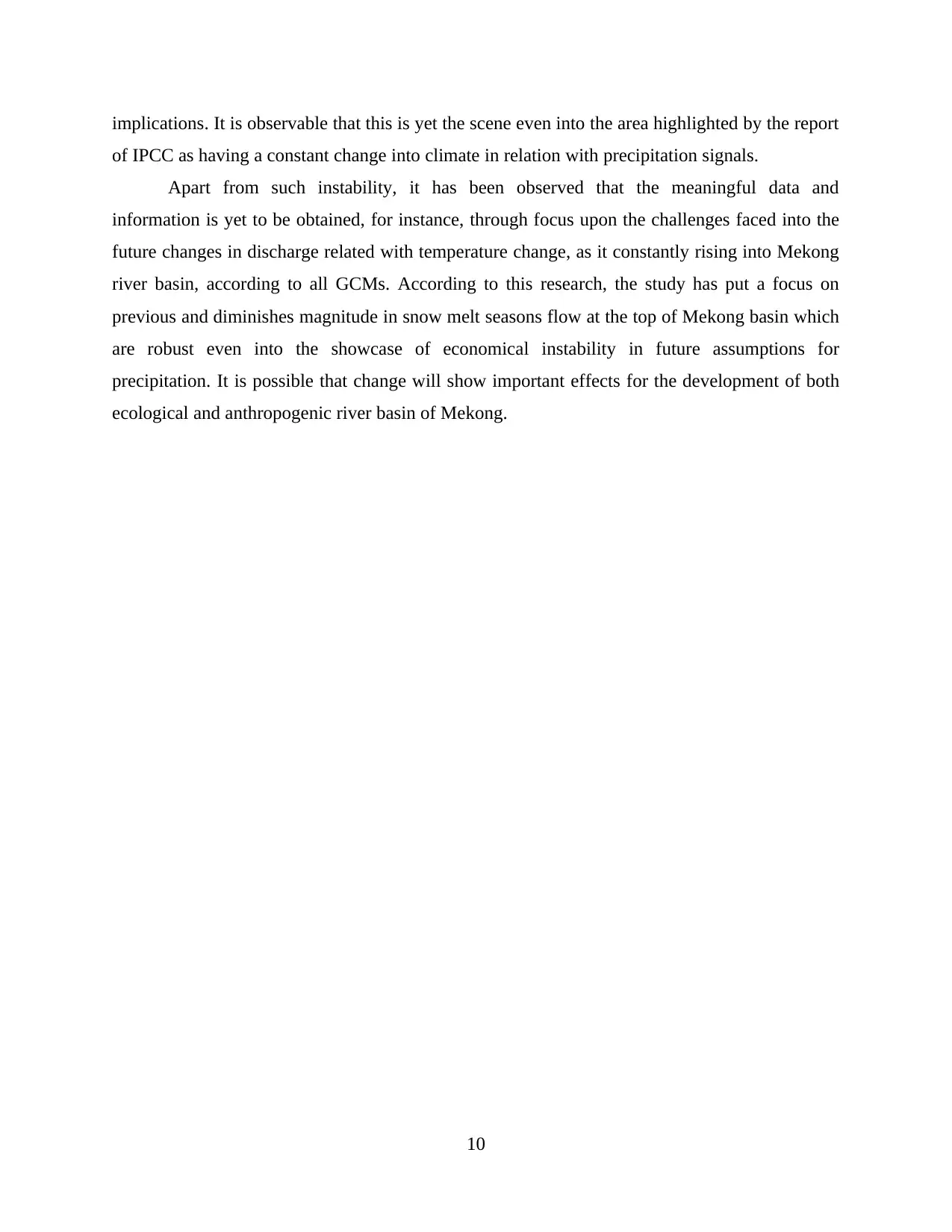
implications. It is observable that this is yet the scene even into the area highlighted by the report
of IPCC as having a constant change into climate in relation with precipitation signals.
Apart from such instability, it has been observed that the meaningful data and
information is yet to be obtained, for instance, through focus upon the challenges faced into the
future changes in discharge related with temperature change, as it constantly rising into Mekong
river basin, according to all GCMs. According to this research, the study has put a focus on
previous and diminishes magnitude in snow melt seasons flow at the top of Mekong basin which
are robust even into the showcase of economical instability in future assumptions for
precipitation. It is possible that change will show important effects for the development of both
ecological and anthropogenic river basin of Mekong.
10
of IPCC as having a constant change into climate in relation with precipitation signals.
Apart from such instability, it has been observed that the meaningful data and
information is yet to be obtained, for instance, through focus upon the challenges faced into the
future changes in discharge related with temperature change, as it constantly rising into Mekong
river basin, according to all GCMs. According to this research, the study has put a focus on
previous and diminishes magnitude in snow melt seasons flow at the top of Mekong basin which
are robust even into the showcase of economical instability in future assumptions for
precipitation. It is possible that change will show important effects for the development of both
ecological and anthropogenic river basin of Mekong.
10
Paraphrase This Document
Need a fresh take? Get an instant paraphrase of this document with our AI Paraphraser

REFERENCES
Books and Journals
Bastakoti, R. C. and et. al., 2014. Climate risks and adaptation strategies in the Lower Mekong
River basin. Regional environmental change. 14(1). pp.207-219.
Cui, T. and et. al., 2018. Assessment of the impact of climate change on flow regime at multiple
temporal scales and potential ecological implications in an alpine river. Stochastic
Environmental Research and Risk Assessment. 32(6). pp.1849-1866.
Escobar, N. and et. al., 2017. Multiyear Life Cycle Assessment of switchgrass (Panicum
virgatum L.) production in the Mediterranean region of Spain: A comparative case
study. Biomass and Bioenergy. 107. pp.74-85.
Fang, L. L. and et. al., 2016. Life cycle assessment as development and decision support tool for
wastewater resource recovery technology. Water research. 88. pp.538-549.
He, Z. and et. al., 2017. Intercomparisons of rainfall estimates from TRMM and GPM
multisatellite products over the Upper Mekong River Basin. Journal of Hydrometeorology.
18(2). pp.413-430.
Keskinen, M. and et. al., 2015. Water-energy-food nexus in a transboundary river basin: The
case of Tonle Sap Lake, Mekong River Basin. Water. 7(10). pp.5416-5436.
Lane, J. L., de Haas, D. W. and Lant, P.A., 2015. The diverse environmental burden of city-scale
urban water systems. Water research. 81. pp.398-415.
Lee, S., 2015. Benefit sharing in the Mekong River basin. Water International. 40(1). pp.139-
152.
Li, R. and et. al., 2015. Effects of upstream reservoir regulation on the hydrological regime and
fish habitats of the Lijiang River, China. Ecological engineering. 76. pp.75-83.
Saswattecha, K. and et. al., 2015. Assessing the environmental impact of palm oil produced in
Thailand. Journal of cleaner production. 100. pp.150-169.
Suif, Z. and et. al., 2016. Spatio-temporal patterns of soil erosion and suspended sediment
dynamics in the Mekong River Basin. Science of the Total Environment. 568. pp.933-945.
Tatsumi, K. and Yamashiki, Y., 2015. Effect of irrigation water withdrawals on water and energy
balance in the Mekong River Basin using an improved VIC land surface model with fewer
calibration parameters. Agricultural Water Management. 159. pp.92-106.
Thammaraksa, C., Wattanawan, A. and Prapaspongsa, T., 2017. Corporate environmental
assessment of a large jewelry company: From a life cycle assessment to green
industry. Journal of Cleaner Production, 164, pp.485-494.
Thilakarathne, M. and Sridhar, V., 2017. Characterization of future drought conditions in the
Lower Mekong River Basin. Weather and Climate Extremes. 17. pp.47-58.
Thompson, J. R., Green, A. J. and Kingston, D. G., 2014. Potential evapotranspiration-related
uncertainty in climate change impacts on river flow: An assessment for the Mekong River
basin. Journal of Hydrology. 510. pp.259-279.
Wang, W. and et. al., 2017. Evaluation and comparison of daily rainfall from latest GPM and
TRMM products over the Mekong River Basin. IEEE Journal of Selected Topics in Applied
Earth Observations and Remote Sensing. 10(6). pp.2540-2549.
Wang, X. and et. al., 2017. Analysis of multi-dimensional hydrological alterations under climate
change for four major river basins in different climate zones. Climatic Change. 141(3).
pp.483-498.
11
Books and Journals
Bastakoti, R. C. and et. al., 2014. Climate risks and adaptation strategies in the Lower Mekong
River basin. Regional environmental change. 14(1). pp.207-219.
Cui, T. and et. al., 2018. Assessment of the impact of climate change on flow regime at multiple
temporal scales and potential ecological implications in an alpine river. Stochastic
Environmental Research and Risk Assessment. 32(6). pp.1849-1866.
Escobar, N. and et. al., 2017. Multiyear Life Cycle Assessment of switchgrass (Panicum
virgatum L.) production in the Mediterranean region of Spain: A comparative case
study. Biomass and Bioenergy. 107. pp.74-85.
Fang, L. L. and et. al., 2016. Life cycle assessment as development and decision support tool for
wastewater resource recovery technology. Water research. 88. pp.538-549.
He, Z. and et. al., 2017. Intercomparisons of rainfall estimates from TRMM and GPM
multisatellite products over the Upper Mekong River Basin. Journal of Hydrometeorology.
18(2). pp.413-430.
Keskinen, M. and et. al., 2015. Water-energy-food nexus in a transboundary river basin: The
case of Tonle Sap Lake, Mekong River Basin. Water. 7(10). pp.5416-5436.
Lane, J. L., de Haas, D. W. and Lant, P.A., 2015. The diverse environmental burden of city-scale
urban water systems. Water research. 81. pp.398-415.
Lee, S., 2015. Benefit sharing in the Mekong River basin. Water International. 40(1). pp.139-
152.
Li, R. and et. al., 2015. Effects of upstream reservoir regulation on the hydrological regime and
fish habitats of the Lijiang River, China. Ecological engineering. 76. pp.75-83.
Saswattecha, K. and et. al., 2015. Assessing the environmental impact of palm oil produced in
Thailand. Journal of cleaner production. 100. pp.150-169.
Suif, Z. and et. al., 2016. Spatio-temporal patterns of soil erosion and suspended sediment
dynamics in the Mekong River Basin. Science of the Total Environment. 568. pp.933-945.
Tatsumi, K. and Yamashiki, Y., 2015. Effect of irrigation water withdrawals on water and energy
balance in the Mekong River Basin using an improved VIC land surface model with fewer
calibration parameters. Agricultural Water Management. 159. pp.92-106.
Thammaraksa, C., Wattanawan, A. and Prapaspongsa, T., 2017. Corporate environmental
assessment of a large jewelry company: From a life cycle assessment to green
industry. Journal of Cleaner Production, 164, pp.485-494.
Thilakarathne, M. and Sridhar, V., 2017. Characterization of future drought conditions in the
Lower Mekong River Basin. Weather and Climate Extremes. 17. pp.47-58.
Thompson, J. R., Green, A. J. and Kingston, D. G., 2014. Potential evapotranspiration-related
uncertainty in climate change impacts on river flow: An assessment for the Mekong River
basin. Journal of Hydrology. 510. pp.259-279.
Wang, W. and et. al., 2017. Evaluation and comparison of daily rainfall from latest GPM and
TRMM products over the Mekong River Basin. IEEE Journal of Selected Topics in Applied
Earth Observations and Remote Sensing. 10(6). pp.2540-2549.
Wang, X. and et. al., 2017. Analysis of multi-dimensional hydrological alterations under climate
change for four major river basins in different climate zones. Climatic Change. 141(3).
pp.483-498.
11

Wang, X. and et. al., 2018. Impacts of climate change on flow regime and sequential threats to
riverine ecosystem in the source region of the Yellow River. Environmental Earth
Sciences. 77(12). p.465.
12
riverine ecosystem in the source region of the Yellow River. Environmental Earth
Sciences. 77(12). p.465.
12
1 out of 15
Related Documents
Your All-in-One AI-Powered Toolkit for Academic Success.
+13062052269
info@desklib.com
Available 24*7 on WhatsApp / Email
![[object Object]](/_next/static/media/star-bottom.7253800d.svg)
Unlock your academic potential
© 2024 | Zucol Services PVT LTD | All rights reserved.





